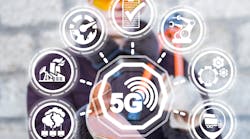The main reason industrial wireless became ubiquitous and transparent is that it was swept along as wireless networking overspread every other mainstream business and consumer environments. However, as connections multiply and data demand grows, once dominant Wi-Fi may give way to private cellular.
“The big transformation is that wireless has taken over every part of life in recent years, except for fiber-optics and power generation. In our personal lives, we have in-house Wi-Fi and data streaming, mobile phones and even wireless security, which is allowing many of us to rip out former networking cables,” says Daniel Quant, VP of strategic development at MultiTech Systems Inc. “Manufacturing has been slower, but all the factories, mines, hospitals, stadiums and even some critical infrastructure that used to have just Ethernet are also going wireless.”
More points, more costs
However, the meteoric rise of wireless has also made it a victim of its own success as many locations and providers struggle to set up and maintain all the coverage that users need. “A few years ago, a typical home might have three to five wireless devices such as phones and PCs, but now its Wi-Fi access point must handle 30 devices as video, lighting, thermostats and other have piled on. It can be a mess of lost connectivity and data, and the same goes for business and industrial locations,” explains Quant. “Consequently, users are increasingly looking for something to replace the usual mesh of Wi-Fi access points serving their multiplying and clashing devices. Many users are presently running 30-50 access points, but their distance is limited, and they aren’t designed to handle hundreds or even thousands of devices. Only cellular and its heavier-duty protocol stack can do this, so more users with hundreds or thousands of devices to connect are taking over from Verizon and ATT, and establishing private, standalone 4G and 5G cellular networks.”
Quant acknowledges that private cellular is initially more costly than Wi-Fi, so it’s important for potential users to evaluate when switching over becomes cost-effective for them. “You pay for what you get,” he adds. “Cellular is already used in mission-critical applications because it’s highly predictable and can process tens to hundreds of megabytes per second (Mbps). Wireless has the same data rates, but its unpredictable and nondeterministic.”
Going private, increasing access
Quant reports that one professional sports stadium that has more than 1,000 Wi-Fi access points, but even its public cellular can’t keep up with all the fans, vendors, security, cameras and other users on game days. The venue has a cellular distributed antenna system (DAS) to amplify public cellular, but it’s planning to migrate to private cellular soon. Installing private, cellular, Citizens Broadband Radio Service (CBRS) ensures that teams and refs can communicate without being on the same technology systems as the public. This option is enabled by the Federal Communications Commission (FCC), which launched a liberalized, shared spectrum in the 3.55-3.7 GHz range that anyone can use with guidance and if they sign up for a spectrum allocation system (SAS) platform assignment. Other bands that can support private cellular include 896-902 MHz that was reordered by the FCC in 2021 to support 3x3 MHz suitable for private cellular, such as those supplied by Anterix.
“The stadium is rolling out a private, cellular network for its critical infrastructure on CBRS that’s part of the FCC’s recently deregulated spectrum,” says Quant. “This is a game changer because liberalized spectrum is like a managed version of the unlicensed Industrial, Scientific and Medical (ISM) bands, where users can access RF spectrum. This is similar to owning an exclusive license without the cost and bureaucracy, which is enjoyed with unlicensed spectrum.”
Let’s make a better deal
At the same time, private cellular requires some capital expenditure (CapEx) at the outset, which goes against the popular trend of using operating expenditures (OpEx) for all spending. However, Quant argues that private cellular is quickly becoming a good investment for many organizations and industries.
“Private, cellular CBRS infrastructure can cost $100,000 to $1 million depending on whether it’s installed in one building or an entire campus. However, either will soon cost less than all those multiplying access points and endless subscriptions,” he explains. “For instance, many school districts quickly deployed private CBRS cellular networks when COVID-19 forced students to working from home. To let them provide reliable, broadband connectivity to underserved neighborhoods and rural communities, and connect all children at less than $10 per user per month, the districts leveraged federal and state stimulus funding to cover initial CapEx costs. This also let the districts reduce OpEx costs by not having to pay ATT or Verizon $30 per user/student per month. Private cellular makes even more sense and delivers its return on investment (ROI) quicker when hundreds of wireless devices become thousands.”
Quant adds the best way to implement wireless is to divvy up its technologies where they can be most effective. For example, broadband cellular should be used to connect people and assets in locations where broadband, wide-area connectivity is required. These include schools, businesses and mission-critical processes that require low latency, such as video cameras, robots and automated guided vehicles (AGV). LoRaWAN should be used for sensors and other narrow-band assets that communicate less frequently. And, Wi-Fi is well suited to worker productivity and IT devices like notebooks, tablets and smart devices.
“Private cellular networks enable a foundational wireless coverage across a building or campus, which can provide an agile data backhaul when needed for other wireless networks like LoRaWAN and Wi-Fi to plug into,” adds Quant. “This is wireless convergence, and MultiTech has a broad portfolio for making connections. We focus on wireless technologies, and our LoRaWAN, cellular and CBRS/Private LTE products enable simple, scalable connectivity between assets and applications. All of these enable organizations to quickly realize the benefits of IoT and achieve true digital transformation.”





